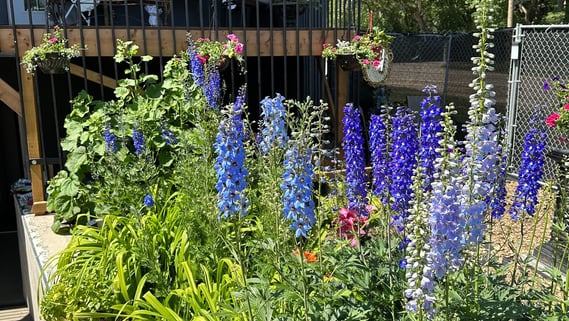Delphinium-The Lady in Blue
The lady in blue has spires that reach up to the sky. Her beauty is not to be underestimated, she's a hard worker supplying medicinal relief and more since early days.
Lorrel Elian
5/22/20243 min read


Delphinium, a beautiful flowering plant, has a rich history dating back to ancient times.
Throughout various cultures, this majestic plant has been utilized for a multitude of purposes.
Delphinium is a genus of herbaceous, flowering plants containing more than 500 species.
These native species, commonly called Larkspurs, include annuals, biennials, and perennials and can often be found growing wild in forests or natural areas in rich woods and in mountains. Some spread in disturbed areas in woods and fields and can become weedy in gardens. Most of the plants sold today are complex hybrids although the Larkspur species that return from seed or perennial rootstocks every year perform much better in the warm gardens of the South than the hybrid Delphiniums.
The genus name comes from the Greek word delphis meaning dolphin in reference to the flower bud shape of some species resembling a dolphin. In ancient Greek mythology, it was believed that the delphinium flower derived its name from the shape of its petals resembling a dolphin. It was highly regarded for its medicinal properties and was often used to treat ailments such as digestive issues and skin conditions.
In ancient Egyptian culture, delphinium was associated with the gods and was used in religious ceremonies and rituals. In medieval Europe, it was cultivated for its vibrant blue petals, which were used to create natural dyes for textiles.
Today, delphinium continues to be cherished for its ornamental value, adorning gardens and bouquets with its stunning blooms. Its vibrant colors and tall spikes make it a popular choice among gardeners and floral enthusiasts alike.
Delphinium flowers, with their vibrant hues and elegant spikes, are one of my favorites. Caring for these stunning blooms is relatively easy, making them a popular choice.
Delphiniums love a sunny location with well-draining soil. Because they grow fairly tall, I tend to place them out of windy locations or to the back of your flower bed so it doesn't block showy efforts of other plants.
Regular watering is essential, especially during dry spells, as they thrive in moist conditions. I hear often that they're finicky and I'm not agreeing as Delphiniums show up for me even when neglected in our hot dry summers.
Be prepared to provide support for their tall stems, as they may become top-heavy and prone to falling over.
An important aspect of caring for delphinium is deadheading the first blooms in early summer. I honestly have never done this and always been pleased with how resilient they are. This gardening season I am commiting to deadheading them. Excited to see how they show up after this and I'll keep you posted.
Remove flower stalks when blooms are spent.
You can expect a bountiful blast of blooms in late summer or early autumn.
This is when delphinium flowers are at their most beautiful.


Uses for Delphinium
The alkaloids and their concentrations vary with the species and plant part involved, which causes variability in toxicity. In Delphinium consolida (larkspur) there are toxic alkaloids in the non-medicinal plant parts (root, seed, herb), but they are purportedly absent in the medicinal part (the flower).
All members of the genus Delphinium are toxic to humans and livestock. The common name larkspur is shared between perennial Delphinium species and annual species of the genus Consolida.
That said, Delphinium is an herb and the flowers are used to make medicine. Despite serious safety concerns, delphinium is used to treat intestinal worms, fluid retention, poor appetite, and trouble sleeping (insomnia). It is also used as a sedative to cause relaxation.
I was surprised by this, as it's not anything I ever heard growing up and all my aunts & grandmother had Delphinium in their garden. I have had many say the same about
